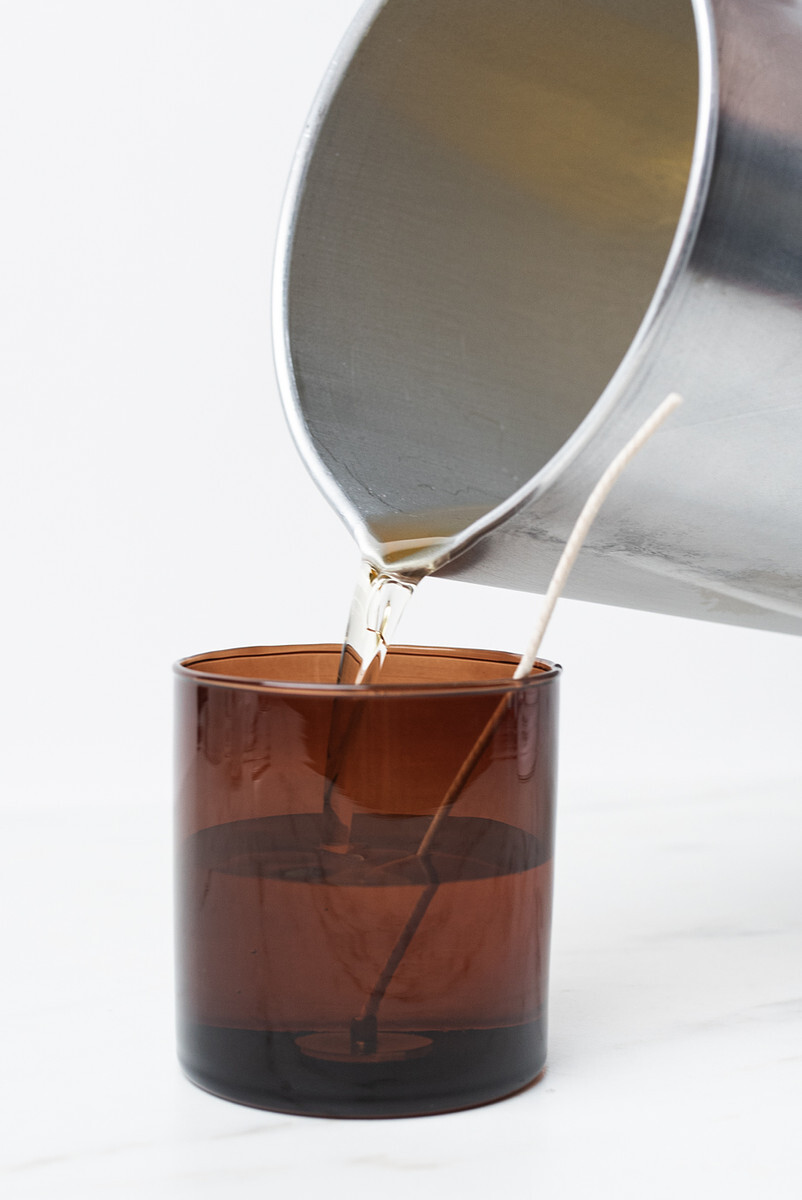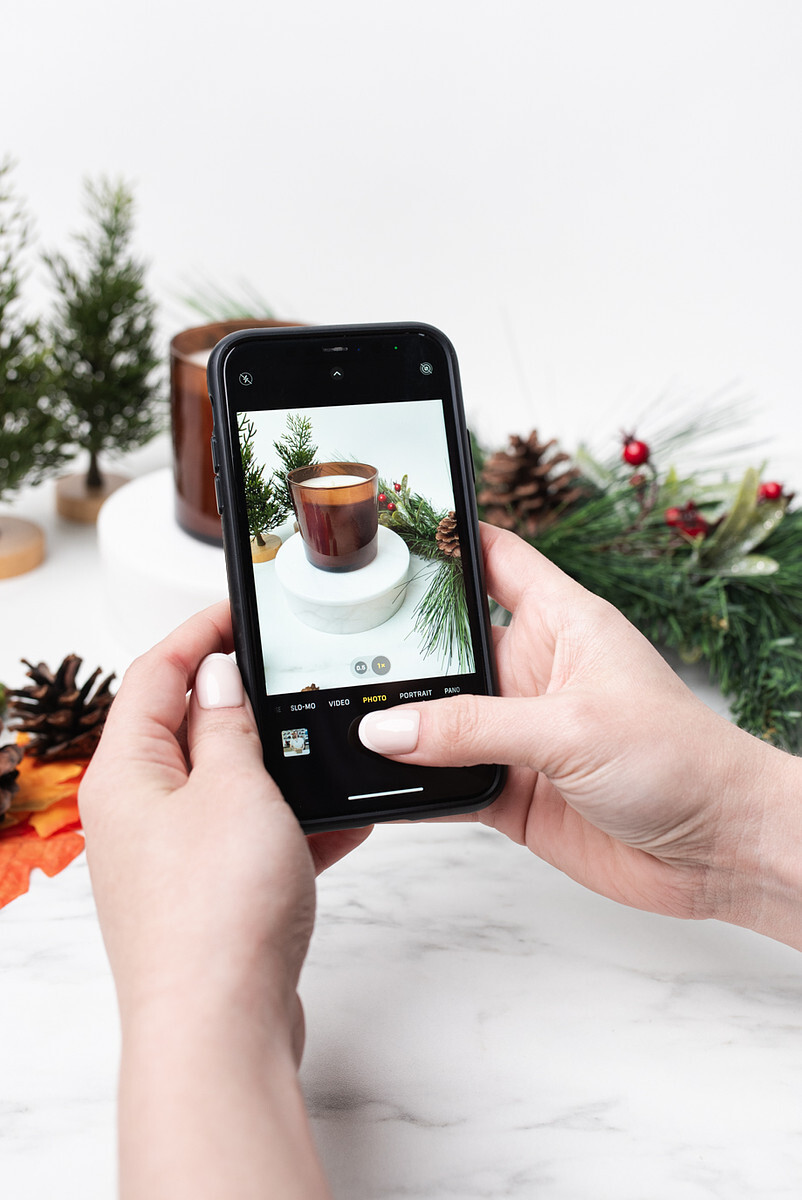The candle maker’s guide to a successful fall and holiday season How to plan, prep for, and pull off your best sales season yet

The fall and holiday season is the time for candle makers and their businesses to shine! As the days grow shorter and colder, customers crave the warm glow and comforting scents that candles provide—both for themselves and for gifts.
Many small candle businesses generate up to 50% of their entire annual sales from September through December. While that potential for profit is quite exciting, the sheer amount of work involved can be overwhelming. Where and when do you start? What tasks should be prioritized?
For candle businesses that sell directly to consumers, have their own website, and use social media and email for marketing, this comprehensive guide is here to help you navigate this bustling period. With a timeline, strategies, and actionable steps for planning, production, marketing, and fulfillment, you can make the most of the cozy autumn and winter months when candles are in high demand.
Be sure to download the checklist version of this guide so you can mark your progress as you go!
Get the checklist >>
Summer: Planning and preparation time
The key to a successful fall and holiday sales season begins in the summertime. Even though considering pumpkin and pine scents feels out of sync with June and July heat, your future self will thank you for planning thoughtfully and preparing now!
Grab a calendar, along with your computer or notebook, and dedicate several days to this critical task. The analysis you do and the decisions you make at this point are the foundation for the rest of the year—and will pave the way for a more rewarding holiday season.
1. Forecast for this year
Forecasting is looking at past and present information to predict a future outcome. If you’ve been in business for at least a year, you have sales information and other data that will help you forecast for the upcoming busy season. To forecast:
- Gather and review last year’s sales figures.
- Pay special attention to your previous September through December sales to understand how much business you might expect to do.
- Analyze what products were popular and which didn’t perform well.
- Notice which sales or promotion strategies worked and which ones left room for improvement.
- Determine if you need to hire seasonal employees to make, market, and otherwise meet the demand you predict.
Remember to adjust your forecasts based on how your business has grown or changed over the past year, and consider your current cash flow situation too. This information is invaluable as you plan your supply orders and production schedule in the next phase of preparations.
While you’re planning for your business, it’s also important to set up support systems for you. The fourth quarter and holiday season can be overwhelming so enlist the help of a partner, family, or friends. Consider arranging for grocery deliveries, household management assistance, and anything else that will ease the burden of this busy time!
2. Determine product and collection lineups
Now that you have an idea of the products that sold well and what’s worked in the past, the next step is to decide on this year’s product lineup. Tried-and-true favorites often form the core of your offerings, but don’t be afraid to introduce new products to keep things fresh, interesting, and appealing.
- Figure out which seasonal collections you want to carry. Among autumn, Halloween, and the various holidays that fall in the final few months of the year, there’s no shortage of options. Whatever you choose, these collections usually involve a mix of bringing back successful products and adding in some new scents. Check now to see if your suppliers have any specialty containers or new fragrances that you might want to use in your product line.
- Consider creating gift sets and bundles. They’re a convenient way for shoppers to select thoughtful gifts and often generate more sales for you! When planning gift sets, candle samplers, or bundles, think about offering them at different price points that appeal to various budgets. They can also:
- Set launch dates. As you plan your lineup, when will each collection debut? If you’re offering limited edition items, how long will they be available? Note these dates now to shape your production schedule and marketing efforts in the months to come.
- Review your pricing. If creating new products, calculating your costs to arrive at profitable pricing is a must. For returning or existing products, also re-run the numbers and don’t hesitate to adjust prices to cover any cost changes for raw materials and supplies.
3. Decide on events, sales, and promotions
As the weather cools off, shopping heats up; this fall and holiday season is ripe with opportunities to sell your candles at in-person markets and shows, and online.
If vending at markets is part of your business model, you may already have some on the books. But it’s not too late to research and apply for more if you have the capacity. In addition to markets and shows, consider pop-up opportunities at shops in high-traffic areas and collaborations with complementary businesses.
Key shopping periods to plan for include:
- Halloween (October 31)
- Black Friday (the day after Thanksgiving)
- Small Business Saturday (Saturday after Thanksgiving)
- Cyber Monday (Monday after Thanksgiving)
- Green Monday (the second Monday in December)
- Free Shipping Day (mid-December)
- Super Saturday (the last Saturday before Christmas)
Consumers have come to expect deals this time of year. As a small business, you have to balance meeting these expectations with maintaining your profit margins and brand value. Because it’s not possible to directly compete with deep-pocketed, big retailers that constantly run sales and promotions, you get to be more deliberate and creative in this area. Sales details to consider include:
- Timing: Do you want to align your sales with traditional shopping and sales periods or try a different, perhaps earlier time, to better stand out and capture sales before shoppers have spent their money?
- Particulars: Straightforward discounts are simple and effective, but many small brands prefer value-added promotions like a gift with purchase, free gift wrap, or tiered discounts that encourage larger purchases. Be sure to check your prices and profit margins to help you decide the discounts you’re comfortable with and can afford to make.
- Frequency and duration: Will you hold one big sale to drive urgency and action? Or perhaps some longer-term promotions with a flash sale? There is no single choice that works for every business. The key is to choose an approach that works with your brand, capacity, and goals.
Once you’ve nailed down the dates and details of your sales, you’ll then want to outline a simple launch and marketing plan for each one. A classic sale rollout includes these phases:
- Pre-launch: Teaser posts and emails to build anticipation.
- Launch day: Coordinated announcements across your website, email, and social channels.
- During the sale: Sale reminders to maintain momentum and last-chance messages as the sale nears its end.
- Post-sale: Follow-up content showing customer photos and testimonials.
When structuring your offers and promotions, keep them simple so they’re easy for shoppers to understand and for you to pull off. Being able to clearly communicate the terms and conditions of any sale is also important for preventing confusion.
Here are some examples of promotions that might work for your business:
- 20% off all candles
- Buy 3 wax melts, get 1 free
- Spend $50, get a free bar of soap
- 25% off orders of $75 or more
- Free shipping on all orders or free shipping on orders of $50 or more
4. Choose ordering and shipping cut-off dates
Nothing dampens holiday spirits like a gift that arrives late. By setting and communicating clear cut-off dates for orders and shipments, you’ll increase the likelihood of having happy customers whose orders reach their destinations in time—and drive sales thanks to the urgency that deadlines naturally create.
To choose these dates, you’ll want to work backward and:
- Identify key holidays: Christmas is obvious to many in the U.S., but don’t forget about Hanukkah, Kwanzaa, and even New Year’s Eve.
- Check shipping carrier deadlines: Major carriers like USPS, UPS, and FedEx usually publish their shipping deadlines by September, so mark these dates on your calendar.
- Add in production time and a buffer: How long does it take to make and fulfill an order? Take this amount of time and add in an extra day or two so you can underpromise and overdeliver.
As with sales and promotions, communicating your deadlines is also crucial. Don’t hesitate to pepper this information in a multitude of places like:
- Your website’s homepage with a prominent banner counting down ordering and shipping deadlines.
- A conspicuous note about deadlines on each product page.
- In emails, whether as a series reminding customers about approaching deadlines, or by including reminders in your usual email marketing.
- On social media via posts, Stories, and Reels.
- During checkout with a message in the cart. Some makers even require customers to check a box acknowledging ordering and shipping deadlines before completing their purchase.
Offering digital gift cards is an excellent option for last-minute shoppers and a way to capture sales when you’re either no longer shipping orders or when shipping deadlines have already passed. They are delivered instantly and Shopify offers digital gift cards on all of its subscription plans.



August: Final prepping and time for action
As August arrives, the excitement of the upcoming season is building! This is the month you put your carefully laid plans into motion. Let’s dive into the key tasks that will prepare you and your business for the final months of the year.
1. Get your workspace ready
Creatives are not always known to be the most organized, so it can be helpful to take stock of your work area before you dive into the throes of making. Whether you need a simple tidy or deeper organization, the purpose is to create an environment that will support increased production, maintain efficiency, and preserve your sanity.
This is an excellent opportunity to identify if you need any additional tools or equipment to make candle making more efficient and productive. If you don’t already have a dedicated shipping station or area, it can be useful to set one up. This will streamline your order fulfillment and help make this one aspect of the busy season less stressful.
2. Order supplies and packaging
As the saying goes, “By failing to prepare, you are preparing to fail.” This couldn’t be truer when it comes to having the materials and supplies you need to carry your business through the next several months. To make sure you’re ready:
- Refer to your forecasting: Base your initial wax, fragrance, candle container, wick, and other candle-making supply purchases on your projected sales.
- Order early: Popular supplies like fall and holiday fragrances can sell out quickly or be intermittently available when needed the most. Ordering early guarantees you can source these critical supplies!
- Buy in bulk: This not only ensures you have enough supplies on hand to make the inventory you’ll need, but you can save money in the process. A benefit of bulk purchasing is that your per-piece and per-ounce costs are reduced. Plus larger orders can be sent most cost-effectively through UPS Hundredweight and freight shipping.
- Don’t forget shipping materials: Stock up on packing materials like peanuts, honeycomb wrap, and bubble wrap, shipping boxes like the free ones available from USPS, Flush Packaging’s sturdy, specialty boxes, product labels and inserts like those available from Avery WePrint (CandleScience customers receive 10% off!), as well as shipping tape and tissue paper. Most of these items are usable past the holiday season so it’s okay if you happen to buy more than you think you’ll need.
3. Start making products
With supplies in hand and your workspace ready to go, it’s production time!
First, prioritize making any new products so you can shoot photos and other images for marketing materials—and perhaps for some sneak peeks.
Then, start stocking bestsellers, whether seasonal or year-round favorites, and assemble gift sets and bundles. If you can, make extra quantities of your most popular items. This buffer can save you from the stress of rushing to make and ship orders or from having to set high-demand products to out-of-stock.
Every candle poured now is one less you’ll need to make during peak season. Advanced production leads to more ease in meeting demand, maintaining quality, and reducing stress. By the end of August, you should have a robust inventory of seasonal candles and products—as well as confidence that you’re poised for success in the coming months!
4. Check your website and policies
Take the time to make sure your website is in shape to give visitors a strong first impression and excellent user experience. Be sure to review:
- Site copy and FAQs: Can you find typos or any wonky formatting? Edit them so your website is as professional and credible looking as it can be. Help customers by pre-emptively providing answers to commonly asked questions.
- Mobile performance: More shopping than ever before is happening on phones and tablets. View your site on a mobile device to be sure it’s easy to navigate, read, and make purchases on a smaller screen.
- Page load speed: A slow site can cause customers to click away, but tools like PageSpeed Insights can identify any issues.
- Navigation: Is your site’s navigation intuitive? Is it easy for customers to find what they’re looking for in only a couple of clicks? You might add a temporary “Holiday Shop” or “Gifts” section to your navigation to encourage shoppers to explore seasonal items.
- Checkout: Run through a purchase yourself to see if you encounter any glitches or errors that you can correct now.
- Shipping and return policies: Make sure your shipping options and costs, as well as return conditions, are clear, easy to understand, and up-to-date. If your return policy has a time limit, you might consider extending the return window into January so there is time for gift returns after the holidays.
5. Create product descriptions, photos, graphics, and marketing content
As your candles, soaps, and other products are being made, it’s also time to turn your attention to how you’ll share them with customers and shoppers. All of the following marketing components will support your sales goals:
- Product descriptions: Start by writing compelling descriptions for any new products. Then, see if you can update descriptions for existing products to make them more festive, capitalize on organic searches, or better emphasize why they’re gift-worthy.
- Product photography: High-quality images are crucial, especially for online shoppers who cannot experience your candles and other scented products first-hand. Have a mix of traditional product photos and lifestyle images that can be used across your website, in emails, and on social media.
- Graphics: Like photos, graphics can be used in several ways and are helpful to promote sales, and deadlines, and share social proof like product reviews.
- Email and social media content: Remember those plans you made earlier? Bring them to life by writing the copy for emails and social posts. Create a mix of product highlights, behind-the-scenes looks, social proof, and sales announcements and reminders.
You might feel overwhelmed by the amount of marketing content you’re creating. Batching this work can be helpful and we’ve covered strategies to help streamline taking product photos, creating social media and email marketing content, and repurposing content.
By getting a head start on this part of the fall and holiday season, you can focus on production and fulfillment rather than scrambling to create marketing materials.
6. Schedule future marketing content
As you create promotional content for your products and sales, schedule these posts and emails to maintain a consistent presence without burning yourself out.
Various social media and email marketing platforms offer scheduling functions. Meta Business Suite allows you to create and schedule your Instagram and Facebook posts. Apps like Later and Planoly offer similar capabilities so you can share content at optimal times. And email marketing platforms like Klaviyo and MailChimp enable you to schedule emails in advance.



September through mid-December: The flurry
As the leaves begin to turn, the air grows chilly, and perhaps snow makes an appearance, you’ll find yourself in the thick of the busy season! At this point, all of your planning and preparations are serving you well and now you’re in execution mode. That means you’re:
- Making products: Keep an eye on your candle and product inventory levels and be prepared to adjust your production based on the tempo of sales. Relatedly, monitor your supplies and be ready to reorder before you run out of anything critical.
- Fulfilling and shipping orders: For the sake of efficiency, consider having a set time or day for packing and shipping orders. Working in a batch mindset can help reduce fulfillment errors that may cost you money down the line. If you ship with USPS, schedule pick-ups to save yourself a trip to the post office.
- Keeping on top of marketing efforts: Your marketing engine is humming along now with pre-scheduled posts and emails going out, but don’t set and forget them. Routinely check your analytics to see what posts or emails are performing well so you can potentially replicate what’s working. Engage with comments and messages promptly, too, because these interactions can lead to sales. Remember, people are actively shopping this time of year so don’t be shy about promoting your offers and products!
- Responding to customer service inquiries: Having prewritten emails that address common customer service questions or issues can help expedite replies and allow you to respond with more patience and understanding.
- Taking care of yourself (as best as you can): You’re the heart of your business, so staying healthy and motivated is important! Try to keep a routine that includes regular sleep and nutritious meals so you’ll have the energy to meet this exciting moment. Don’t be afraid to lean on your family and friends whenever you start to get overwhelmed.
During this time, it’s also okay and necessary to make adjustments as you go. Even though you’ve planned meticulously, unanticipated hiccups may occur, whether it’s a new product selling way faster than expected or a particular promotion not performing as you’d hoped. Flexibility is a trait that will serve you well and going with the flow will help when a pivot is needed.
Late December into early January: The wrap-up
Once the holiday frenzy begins to wind down, you’re in the home stretch! It’s time to transition to the last phase of this season, which involves reflection and a bit of housekeeping:
- Congratulate yourself on making it through: First and foremost, take several moments to acknowledge all of your hard work. You’ve just navigated the busiest time of the year for a candle business and that’s no small feat.
- Update your website: Change out seasonal messaging, graphics, and images, and remove out-of-season products or put them on sale.
- Assess remaining inventory: Take stock of what products and supplies are left so you can determine if you need to order more supplies to begin the new year.
- Look over the finances: Analyze your sales figures. How did they perform compared to your forecasts? Which products were hits? Which promotions worked best?
- Review customer feedback: Read through customer messages or reviews to glean ideas for making product and service improvements. And note the praise that you and your products received, too!
- Thank your customers: Consider sending out a thank you email to your customer base to express your gratitude and appreciation for them. You might even offer a special discount to encourage purchases in the new year.
- Capture ideas while they’re fresh: Jot down the highlights of the season—the products and strategies that worked—so you’ll know what you want to do again next year. By the same token, also reflect on what you’d like to improve or change next time.
- Rest and recharge: Give yourself permission to take a well-deserved break! The holiday season is intense and you’ve more than earned some downtime. If you’re in a place that’s dark and cold this time of year, embrace the slower pace and cozy moments to help you revive and prepare for the new year ahead.
Final thoughts
The fall and holiday season is a marathon for many candle makers and small business owners. It requires careful planning, adaptability, and a lot of hard work. But with preparation and planning, it can also be incredibly rewarding—both financially and personally.
As you look back on this season and forward to the next, take pride in the little wins and all that you’ve accomplished. Whether this was your first holiday season or your fifteenth, each year brings new lessons, opportunities for your business to evolve, and occasions to grow in your craft.
Here’s to a successful holiday season for your candle business!
If you found this guide helpful, please let us know in the comments! We’d love to hear about any ah-ha moments you had or if you have other tips for making this season a success. While this article focused on retail businesses, let us know if you’d like us to make a guide to wholesaling during the holidays!
And for more help on topics like building your brand, creating a product line, setting profitable prices, and overviews of where to sell your candles, visit our Candle Making Business Guides.